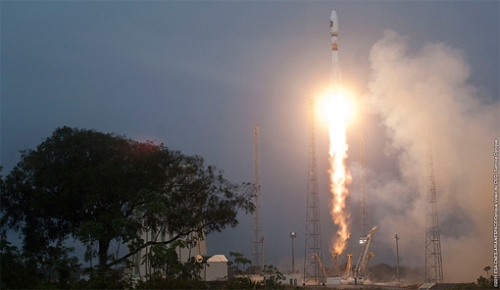1800 Launches for the Soyuz Booster
Monday saw the 1,800th launch of the Russian Soyuz booster, a rocket updated, but also still very recognizable, as an immediate successor to the radio guided R-7 ballistic missile which was first planned in 1953.
The record-setting launch, conducted from the space launch facility at Baikonur in Kazakhstan, was carried out on the Soyuz-U variety of the venerable rocket, which boosted a Russian Progress freighter to the International Space Station. The mission is designated under the Station program as Progress-50 and under the Russian system as Progress M-18M. Progress 49 is still attached to ISS where it is slowly being filled with trash for eventual disposal. Mission controllers made room for the station’s newest arrival on Saturday by undocking the Progress 48 ship, and sending it on a de-orbit trajectory into the upper atmosphere.
The launch took place on time at 9:41 EST, (8:41 PM local) and carried 764 lbs of propellent, 110 lbs of oxygen and air, 926 lbs of water and 3,000 lbs of spare parts. It followed the recently introduced fast ascent trajectory which brought the freighter within docking proximity after only four orbits.
The Progress freighter has a long and distinguished history itself, having been used to ferry cargo more than 130 times in a career which has seen it supply the Salyut, Mir and ISS programs.
The record compiled by the Soyuz, which conducted a commercial launch out of Baikonur just last week, is truly remarkable, but it also says something very disturbing about the progress, or the shocking lack there-of, of the American launch vehicle industry. While the old saying that “if it ain’t broke don’t fix it,” easily justifies Russia’s continued use of the somewhat archaic booster design, particularly for government launches such as the Soyuz crew and Progress cargo ships, it doesn’t exactly explain the vehicle’s ongoing commercial success. In 2011, Arianespace which has been marketing the Soyuz commercially through its partnership with Starsem, brought the Soyuz to its South American launch center in French Guiana. The move was a smart one for Arianespace, which having concentrated all its efforts on the heavy lift Ariane V, otherwise lacked a medium lift vehicle. The cost of establishing a new launch center for the Soyuz-2 , as well as making a series of modest changes to allow it to prosper in tropical conditions, was on the order of $500 million, but justifiable due to the complete absence of a U.S. entry in the medium lift market.
The question Americans might want to ask themselves is why that was the case in the first place. Specifically, was the demise of the highly popular Delta II inevitable because costs could not be contained, or was it ultimately another casualty of the Evolved Expendable Launch Vehicle Program which established mission success, but at the cost of creating a monopoly which became so expensive and uncompetitive it removed the U.S. from the global commercial launch industry entirely?
NASA recently assigned three launches to EELV contractor United Launch Alliance to be conducted on three of the last five remaining Delta II rockets. The launches will no doubt be accopanied by a certain amount of nostalgia for the rocket, but they should also be considered in the context of what happened to the U.S. commercial launch industry. The cumulative launch award was for $412 million, or approximately $137 million per launch. At the risk of belaboring the obvious, the same day NASA announced the Delta II contracts, the agency also awarded SpaceX its first Falcon 9 science mission at $82 million. A $55 million difference between a “bulk” order (3), for a rocket which was already substantially built and a considerably higher performing rocket which wasn’t. In the conventional business world, old inventory with substantial storage costs are heavily discounted, but then again as we are constantly reminded, this isn’t conventional business.
The point here isn’t that NASA should have awarded all the launches to SpaceX, far from it. Rather, in the absence of a coherent policy which prioritized and promoted launch competitiveness, the United States has allowed itself to become a footnote in the commercial launch industry. (SpaceX again excepted), and the EELV program which was in fact promoted on just that basis, has been the major culprit.
It is more than an arcane issue for policy wonks. SpaceX is making a major progress in addressing the issue of launch costs, but what the U.S. and the world needs in order to insure those gains, is an open, competitive environment which drives further innovation. Understanding how the one nation which went to the Moon, and supposedly prizes free market capitalism and open economic competition as one of its core values, surrendered its presence in the global launch market is an important point in making sure it doesn’t happen again.
All that said, congratulations Soyuz, that’s one hell of record.


